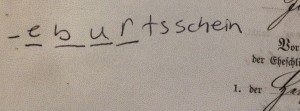For many of us we put off working on our German ancestors because we are afraid of having to read the Old German script, chicken scratch we say! But you absolutely have to be able to read some things, as German church book records are one of the main ways to follow your family line back and verify that you have found the right village. You may have inherited a German document that may contain the village name, so you must be able to read it, so we have a very helpful guest blog post this week from Katherine Schober, a German translator, who gives us some tips.
Ten Tips for Deciphering German Handwriting
As anyone who has ventured into the world of German genealogy knows, the handwriting used in Germany before the second half of the 20th century is very different from the handwriting used in Germany today. This old-fashioned script, known as Kurrentschrift, was taught in German schools until 1941, when the government declared that a Latin-based font (the script we use) was to be the new form of writing in the country. While this makes communication with modern Germans much easier, the words of our ancestors nevertheless remain written in the ever-elusive script. Having worked with many such documents as a professional genealogy translator, I have learned that deciphering the old handwriting can be like learning to read another language. While I recommend hiring a professional for the best results (I would love to be of service), here are some tips for deciphering old German handwriting that I have gathered along the way:
- Identify letters by the clues they offer.While deciphering old-handwriting can feel like solving an incredibly difficult puzzle, the letters themselves often provide nice little clues for us. For example:
* “h” has a loop both above and below the line. It is easily identifiable in the word “Tochter” (daughter) below.
* “u” has a little “swoop” (my non-technical term) above it and “i” has a dot above it. Word of warning: sometimes the swoop or the dot can be slightly to the right of the actual letter itself. Notice also how everyone’s “swoops” can be slightly different, as seen in the real-life example of the word “gut” (good) below.
* A straight line above a letter can mean that it is an “n” or an “m” and that there should be two of them. For example, “kommen” (to come) would likely be written with one “m” with a straight line above the letter. Word of warning: Sometimes the “u-swoops” are written as straight lines. Umlauts can be written as straight lines as well.
This example reads “den es” with a straight line above the “n”, which results in “denn es” (because it).
- Use your insider information to differentiate between the letters that are agonizingly similar.Although I’m sure the inventors of Kurrentschrift weren’t trying to cause problems for 21st-century readers, they made some of those letters very, very similar to one another. However, if you are familiar with their subtle differences, you can beat the system.
* “e” and “n”: The “n” (left image below) is written as one unit in a single stroke, while the “e” (right image) is written with two strokes. The “n” is more jagged-looking than the “e”, while the “e” is usually written as a narrower letter. Notice how the “e” is narrower than the “n” in the real-life image of “denn” above.
* “n” and “m”: My trick for distinguishing between “n” and “m” in a word is to count the points at the bottom of the letter. The “n” has three total points at the bottom, while the “m” has four. This sounds obvious, but when you have a word with “en” or “em”, all these letters start to look the same. It helps me to identify the “e”, separate it off from the rest of the word with a line, and then count the points at the bottom of the next letter to see how many there are. In the example below, the word is “mein” (my). You can identify the “m” at the beginning of the word by counting the four points at the bottom and the “n” at the end by noticing the two points after the “i.”
3. Love your letter “S”.Although “s” can be quite tricky, as there are at least three different ways to write it, it is usually pretty easy to identify as each version is somewhat unique from the other letters in the alphabet (none of this e-n-m difficulty).
These three letters above are all “s”. The first letter shown is used at the beginning of a lowercase word or a syllable (i.e. in “schreiben” – to write). The second “s” is used at the end of a syllable/word (i.e. in “es- it). The final is the capital “S”, used for nouns (always capital in German) and names. See the word “es” in the example of “denn es” in Tip 1.
- Know your abbreviations.If you come across a letter or two all by themselves, it could easily be an abbreviation. This websiteallows you to type the German abbreviation into its search machine to see what the German word could be. A very common example in genealogical documents is “u.” for “und” (and).
- Keep your mind in the past.By this I mean – don’t let your brain automatically read the letters as it would a modern-day document. Many of the letters in Kurrentschrift look similar to our cursive today, but are not actually the same letter. It is easy for your mind to simply read them as the letter you learned in school, but don’t give in! The most difficult for me at the beginning was constantly thinking an “e” was an “n”.
- Play hangman.Once you have identified as many letters in a word as you can, write them out, leaving a blank for the letter(s) you don’t know. With your knowledge of the context or of the German language, see if you can figure out what the missing letters are. I also find this website very helpful. It allows you to type in either the beginning or end of the word and then provides you a list of all the possible German words with those exact beginnings or endings.
In this example, I filled in the letters I recognized one by one, until only the tricky letter at the beginning was left. It was then obvious that this word must be “Geburtsschein” or “birth certificate.
- Forget all you know about writing rules.Punctuation? Who needs it? Writing one word on one line? Not for our ancestors! Many historical writers simply did not use periods or commas. While this usually doesn’t make handwriting transcription too difficult, the lack of line rules does. What do I mean by that? In a letter or document, a word may start on one line, and then, without a dash or any type of punctuation, simply continue onto the next line. So if the letters at the end of the line do not seem to be forming any type of word, remember to look to the next line to see if the word continues there.
- Google, google, google.I can’t imagine translating without it. With the possibility of old fashioned words in historical documents, you may not recognize every word you come across. If you aren’t exactly sure of your transcription, try typing variations of the word into Google search to see which version most frequently appears in other texts and see if they make sense within your document and for your current transcription. The same can be true for last names. Deciphering names can be difficult because there is no context to tell you if you are right or wrong. Try typing the name you think it could be into Google and see if other examples come up. If not, you probably have a letter wrong. Thiswebsite is also a great tool, showing you the frequency of a last name in the different regions of Germany.
- Become geographically-inclined(or just use Google Maps). If you know from the context of the document that a certain word is a city or district, but aren’t sure of the exact letters, use Google or Google maps to see if you can find a city that matches your possible transcription in the area where your document is from. The Google auto-correct “Did you mean….” is often very helpful.
- Always let the document be your guide(Jiminy Cricket’s second piece of advice).
Everyone’s handwriting is different, and a certain letter from an 1890 birth certificate may look completely different from the same letter in a World War II military record. If you are able to identify a letter in your current document, remember it, and then look for other occurrences of the same letter throughout the text. I recently translated a letter in which the “s” looked like our modern “r” (I know, I know, I said the “s’s” were easy-they usually are). Once I realized this was an “s’ based on my hangman type game, I was able to easily identify other “s’s” in the document and therefore many other words.
So there you have it! As you have probably picked up, there are exceptions to every rule. Our ancestors were people too, meaning that their handwriting, level of education, vocabulary and so on varied immensely. Nevertheless, I hope that these ten tips can be a start for helping you with your old German handwriting challenges. And if you would like a professional to translate your documents, I’d be happy to help – contact me at language@sktranslations.com
Image Credit: All Kurrentschrift letter examples, including the above image, are from the Kurrentschrift wikipedia page. All real letters are either my own or published with permission of the client. Jiminy Cricket Image: disney.wikia.com














